Assessing Land-Cover Changes in the Natural Park ‘Fragas do Eume’ over the Last 25 Years: Insights from Remote Sensing and Machine Learning
Abstract
:1. Introduction
2. Materials and Methods
2.1. Study Area
2.2. Methodological Framework
2.2.1. Pre-Processing of Satellite Images
2.2.2. Supervised Classification Procedure
2.2.3. Change Analysis
3. Results
3.1. Accuracy Assessment
3.2. Change Analysis
4. Discussion
5. Conclusions
Author Contributions
Funding
Data Availability Statement
Conflicts of Interest
References
- Shvidenko, A.; Barber, C.V.; Persson, R. Forests and woodland systems. In Ecosystems and Human Well-Being: Current State and Trends; Island Press: Washington, DC, USA, 2005; Volume 1, pp. 587–621. [Google Scholar]
- Thompson, I.; Mackey, B.; McNulty, S.; Mosseler, A. Forest resilience, biodiversity, and climate change. In A Synthesis of the Biodiversity/Resilience/Stability Relationship in Forest Ecosystems; Technical; Secretariat of the Convention on Biological Diversity: Montreal, QC, Canada, 2009; Series No. 43. [Google Scholar]
- Halleux, V. Preparing the Post-2020 Biodiversity Framework; Servicio de Investigación del Parlamento Europeo: Luxembourg, 2020. [Google Scholar]
- Convención de las Naciones Unidas de Río de Janeiro Sobre la Diversidad Biológica. 5 de junio de 1992. Available online: https://www.cbd.int/doc/legal/cbd-en.pdf (accessed on 24 September 2024).
- Directiva 92/43/CEE de 1992 [Consello das Comunidades Europeas] Relativa á Conservación dos Hábitats Naturais e da Fauna e Flora Silvestres 21 de Maio de 1992 DO, C.E. No. 206. Available online: https://eur-lex.europa.eu/LexUriServ/LexUriServ.do?uri=CONSLEG:1992L0043:20070101:es:PDF (accessed on 24 September 2024).
- Directiva 2009/147/CE de 2009 [Parlamento Europeo e Consello da Unión Europea]. Relativa á Conservación das Aves Silvestres. 30 de Novembro de 2009. D. O. I. 184. Available online: https://eur-lex.europa.eu/legal-content/ES/TXT/?uri=celex%3A32009L0147 (accessed on 24 September 2024).
- Banco de Datos da Natureza. Mapa Forestal de España (MFE50). Ministerio para a Transición Ecolóxicae o Reto Demográfico [MITECO]. 2010. Available online: https://www.miteco.gob.es/es/biodiversidad/servicios/banco-datosnaturaleza/informacion-disponible/mfe50.aspx (accessed on 24 September 2024).
- Ministerio para a Transición Ecolóxica e o Reto Demográfico [MITECO]. 9 Bosques. 2005. Available online: https://www.miteco.gob.es/es/biodiversidad/temas/espacios-protegidos/red-natura-2000/rn_fichas_esp_bosques.aspx (accessed on 24 September 2024).
- Roces, J.V.; García, L.; Colina, A.; Álvarez, P.; Atlánticos, B. Evaluación de los Ecosistemas del Milenio de España (EME); Universidad de Oviedo-INDUROT: Mieres, Spain, 2016. [Google Scholar]
- Teixido, A.L.; Quitanilla, L.G.; Carreño, F. Fragmentación del bosque y pérdida del hábitat de helechos amenazados en el Parque Natural Fragas do Eume (NW de España). Ecosistemas 2009, 18, 60–73. [Google Scholar]
- Seidl, R.; Thom, D.; Kautz, M.; Martin-Benito, D.; Peltoniemi, M.; Vacchiano, G.; Wild, J.; Ascoli, D.; Petr, M.; Honkaniemi, J.; et al. Forest disturbances under climate change. Nat. Clim. Chang. 2017, 7, 395–402. [Google Scholar] [CrossRef] [PubMed]
- Castroviejo, S.; Aedo, C.; Cirujano, S.; Laínz, M.; Montserrat, P.; Morales, R.; Garmendia, F.M.; Navarro, C.; Paiva, J.; Soriano, C. (Eds.) Flora Ibérica 2: 17–36; Real Jardín Botánico, CSIC: Madrid, Spain, 1990. [Google Scholar]
- García-Borregón, R.; Fernández, R.; Bris, B.; Ramil, P.; Crecente, R.; Ferreiro, J.; Hinojo, B.A.; de Novoa, B.; Rubinos, M.A.; Rodríguez, M.A.; et al. Plan Director da Rede Natura 2000 de Galicia: Anexo VI: Espazos das Áreas Montañosas; Xunta de Galicia: Santiago de Compostela, Spain, 2012; pp. 23–41. [Google Scholar]
- Tecnologías y Servicios Agrarios, S.A. (TRAGSATEC). Cuarto Inventario Forestal Nacional: Galicia; Ministerio de Medio Ambiente, y Medio Rural y Marino: Madrid, Spain, 2011; Available online: https://www.miteco.gob.es/es/biodiversidad/temas/inventarios-nacionales/galicia_tcm30-531786.pdf (accessed on 24 September 2024).
- Villanueva-Aranguren, J.A.; Manuel-Valdés, C.M.; Gil-Sánchez, L. Tercer inventario forestal nacional 1997–2006: A Coruña, Lugo, Ourense, Pontevedra; Ministerio de Medio Ambiente: Madrid, España, 2002. [Google Scholar]
- Tomé, M.; Almeida, M.H.; Barreiro, S.; Branco, M.R.; Deus, E.; Pinto, G.; Silva, J.S.; Soares, P.; Rodríguez-Soalleiro, R. Opportunities and challenges of Eucalyptus plantations in Europe: The Iberian Peninsula experience. Eur. J. For. Res. 2021, 140, 489–510. [Google Scholar] [CrossRef]
- Madeira, M.; Cortez, N.; Azevedo, A.; Magalhães, M.C.; Ribeiro, C.; Fabião, A. As plantações de eucalipto e o solo. In O eucalipto em Portugal-Impactes Ambientais e Investigação Científica; En Alves, A.M., Pereira, J.S., Silva, J.M.N., Eds.; Departamento de Ciências do Ambiente, Instituto Superior de Agronomia, Universidade Técnica de Lisboa: Lisbon, Portugal, 2007; pp. 138–174. [Google Scholar]
- Lombao, A.; Barreiro, A.; Carballas, T.; Fontúrbel, M.T.; Martín, A.; Vega, J.A.; Fernández, C.; Díaz-Raviña, M. Changes in soil properties after a wildfire in Fragas do Eume Natural Park (Galicia, NW Spain). CATENA 2015, 135, 409–418. [Google Scholar] [CrossRef]
- Ceccon, E.; Martinez-Ramos, M. Aspectos ambientales referentes al establecimiento de plantaciones de eucalipto de gran escala en áreas tropicales: Aplicación al caso de México. Interciencia 1999, 24, 351–359. [Google Scholar]
- Cidrás, D.; Paül, V. Rewilding Shouldn’t Be Reactive: Fragas do Eume Natural Park in the Face of an Invasive Alien Species. J. Nat. Conserv. 2022, 69, 126252. [Google Scholar] [CrossRef]
- Cidrás, D. Reimagining (Un)Protected Areas. An Analysis of Eucalyptus Consolidation in Fragas do Eume Natural Park (Galicia, NW Iberian Peninsula). In Infinite Rural Systems in a Finite Planet: Bridging Gaps towards Sustainability; Paül, V., Lois, R., Trillo, J.M., Haslam-McKenzie, F., Eds.; Universidade de Santiago de Compostela: Santiago de Compostela, Spain, 2018; pp. 187–194. [Google Scholar]
- Decreto 218 de 1997 [Consellería de Agricultura, Gandería y Montes]. Polo que se declara parque naturas ás Fragas do Eume. 11 de agosto de 1997. D. O. G. Núm. 153. Available online: https://www.xunta.gal/dog/Publicados/1997/19970811/AnuncioA37A_es.html (accessed on 24 September 2024).
- Sandoval, A.; Sineiro, R.; Figueroa, R.; de Castro, C. Fragas do Eume: Parque Natural, 2nd ed.; Xunta de Galicia y Terranova: Santiago de Compostela, Spain, 2004. [Google Scholar]
- Consellería de Medio Ambiente, Territorio e Vivenda. Xunta de Galicia. (s.f.). Fauna Vulnerable. Available online: https://cmatv.xunta.gal/seccion-organizacion?content=Direccion_Xeral_Conservacion_Natureza/Biodiversidade/seccion.html&sub=Especies_ameazadas/&ui=Direccion_Xeral_Conservacion_Natureza/Dinamico/Especies/Ameazadas/Fauna_vulnerable/listado_especie_central.html&page=1 (accessed on 18 December 2023).
- Bañares, Á.; Blanca, G.; Güemes, J.; Moreno, J.C.; Ortiz, S. (Eds.) Atlas y Libro Rojo de la Flora Vascular Amenazada de España. Adenda 2017; Ministerio para la Transición Ecológica-Sociedad Española de Biología de la Conservación de Plantas: Madrid, Spain, 2019; p. 220. [Google Scholar]
- Directiva 37/201 [Consellería de Medio Ambiente, Territorio e Infraestruturas]. Polo Que Se Declaran Zonas Especiais De Conservación Os Lugares De Importancia Comunitaria De Galicia E Se Aproba O Plan Director Da Rede Natura 2000 de Galicia. Available online: https://www.xunta.gal/dog/Publicados/2014/20140331/AnuncioCA02-270314-0001_es.html (accessed on 24 September 2024).
- Instituto Geográfico Nacional (IGN). Teledetección. 2020. Available online: https://www.ign.es/web/resources/docs/IGNCnig/OBS-Teledeteccion.pdf (accessed on 24 September 2024).
- Sacristán Romero, F. La Teledetección satelital y los sistemas de protección ambiental. Civilizar 2005, 5, 13–41. [Google Scholar] [CrossRef]
- Pons, X.; Sevillano, E.; Moré, G.; Serra, P.; Cornford, D.; Ninyerola, M. Distribución espacial de la incertidumbre en mapas de cubiertas obtenidos mediante teledetección. Rev. Teledetección 2014, 42, 1. [Google Scholar] [CrossRef]
- Chuvieco Salinero, E. Teledetección ambiental: La Observación de la Tierra Desde el Espacio; 1a. ed. en Esta Presentación, Actualizada; Ariel: Barcelona, Spain, 2008. [Google Scholar]
- Earth Resources Observation and Science (EROS) Centre of the United States Geological Survey (USGS). Available online: https://earthexplorer.usgs.gov/ (accessed on 1 October 2022).
- Sandler, A.M.; Rashford, B.S. Misclassification error in satellite imagery data: Implications for empirical land-use models. Land Use Policy 2018, 75, 530–537. [Google Scholar] [CrossRef]
- García, A.; Martínez, G.L.; Núñez, G.; Guzmán, A. Clasificación supervisada inducción de árboles de decisión, algoritmo k-d. In Proceedings of the Simposium Internacional de Computación CIC-98, Mexico City, Mexico, 11–13 November 1998; Volume 20. [Google Scholar]
- Carletta, J. Squibs and Discussions: Assessing Agreement on Classification Tasks: The Kappa Statistic. Comput. Linguist. 1996, 22, 249–254. [Google Scholar]
- Martínez-Gómez, C.; García-Duro, J.; Pesqueira, X.M.; Basanta, M.; Reyes, O.; Casal, M. Afectou o lume á estrutura e á diversidade vexetal das fragas do Parque Natural Fragas do Eume (NW España)?/Did fire affect the structure and plant diversity of the oak woodlands of the Natural Park Fragas do Eume (NW Spain)? NACC Biol. Nova Acta Cient. Compostel. 2015, 22, 55–68. [Google Scholar]
- Cidrás, D.; Paül, V. Fragas do Eume, 25 años de un parque natural sin plan de gestión: Un estudio crítico desde la ecología política de la conservación. Polígonos. Rev. Geogr. 2021, 33, 1–20. [Google Scholar] [CrossRef]
- López, S.B.; Rivera, J.G.; Sobral, M. Biodiversidad en plantaciones de eucalipto y en robledales del sur de Galicia: Plantas y aves. Nova Acta Cient. Compostel. 2018, 25, 71–81. [Google Scholar]
- Calviño-Cancela, M.; Rubido-Bará, M.; van Etten, E.J. Do eucalypt plantations provide habitat for native forest biodiversity? For. Ecol. Manag. 2012, 270, 153–162. [Google Scholar] [CrossRef]
- Proença, V.M.; Pereira, H.M.; Guilherme, J.; Vicente, L. Plant and bird diversity in natural forests and in native and exotic plantations in NW Portugal. Acta Oecologica 2010, 36, 219–226. [Google Scholar] [CrossRef]
- Goded, S.; Ekroos, J.; Domínguez, J.; Azcárate, J.G.; Guitián, J.A.; Smith, H.G. Effects of eucalyptus plantations on avian and herb species richness and composition in North-West Spain. Glob. Ecol. Conserv. 2019, 19, e00690. [Google Scholar] [CrossRef]
- Nunes, L.J.; Raposo, M.A.; Meireles, C.I.; Gomes, C.J.P.; Ribeiro, N.M.A. The Impact of Rural Fires on the Development of Invasive Species: Analysis of a Case Study with Acacia dealbata Link. in Casal do Rei (Seia, Portugal). Environments 2021, 8, 44. [Google Scholar] [CrossRef]
- Arán, D.; García-Duro, J.; Reyes, O.; Casal, M. Fire and invasive species: Modifications in the germination potential of Acacia melanoxylon, Conyza canadensis and Eucalyptus globulus. For. Ecol. Manag. 2013, 302, 7–13. [Google Scholar] [CrossRef]
- Popović, Z; Bojović, S; Marković, M; Cerdà, A. Tree species flammability based on plant traits: A synthesis. Science of the Total Environment 2021, 800, 149625.
- Pausas, J.G.; Keeley, J.E.; Schwilk, D.W. Flammability as an ecological and evolutionary driver. J. Ecol. 2017, 105, 289–297. [Google Scholar] [CrossRef]
- Pais, S.; Aquilué, N.; Campos, J.; Sil, Â.; Marcos, B.; Martínez-Freiría, F.; Domínguez, J.; Brotons, L.; Honrado, J.P.; Regos, A. Mountain farmland protection and fire-smart management jointly reduce fire hazard and enhance biodiversity and carbon sequestration. Ecosyst. Serv. 2020, 44, 101143. [Google Scholar] [CrossRef]
- Lima, C.G.; Campos, J.C.; Regos, A.; Honrado, J.P.; Fernandes, P.M.; Freitas, T.R.; Santos, J.A.; Vicente, J.R. Fire Suppression and Land-Use Strategies Drive Future Dynamics of an Invasive Plant in a Fire-Prone Mountain Area under Climate Change. SSRN 2023. [Google Scholar] [CrossRef] [PubMed]
- Regos, A.; Ninyerola, M.; Moré, G.; Pon, X. Linking land cover dynamics with driving forces in mountain landscape of the Northwestern Iberian Peninsula. Int. J. Appl. Earth Obs. Geoinf. 2015, 38, 1–14. [Google Scholar] [CrossRef]
- Du, P.; Xia, J.; Zhang, W.; Tan, K.; Liu, Y.; Liu, S. Multiple classifier system for remote sensing image classification: A review. Sensors 2012, 12, 4764–4792. [Google Scholar] [CrossRef]
- Iglesias, M.C.; Hermoso, V.; Campos, J.C.; Carvalho-Santos, C.; Fernandes, P.M.; Freitas, T.R.; Azevedo, J.C. Climate-and fire-smart landscape scenarios call for redesigning protection regimes to achieve multiple management goals. J. Environ. Manag. 2022, 322, 116045. [Google Scholar] [CrossRef]
- Wang, C.; Ren, Z.; Du, Y.; Guo, Y.; Zhang, P.; Wang, G.; Li, T. Urban vegetation cooling capacity was enhanced under rapid urbanization in China. J. Clean. Prod. 2023, 425, 138906. [Google Scholar] [CrossRef]
- Zhang, P.; Dong, Y.; Ren, Z.; Wang, G.; Guo, Y.; Wang, C.; Ma, Z. Rapid urbanization and meteorological changes are reshaping the urban vegetation pattern in urban core area: A national 315-city study in China. Sci. Total Environ. 2023, 904, 167269. [Google Scholar] [CrossRef]
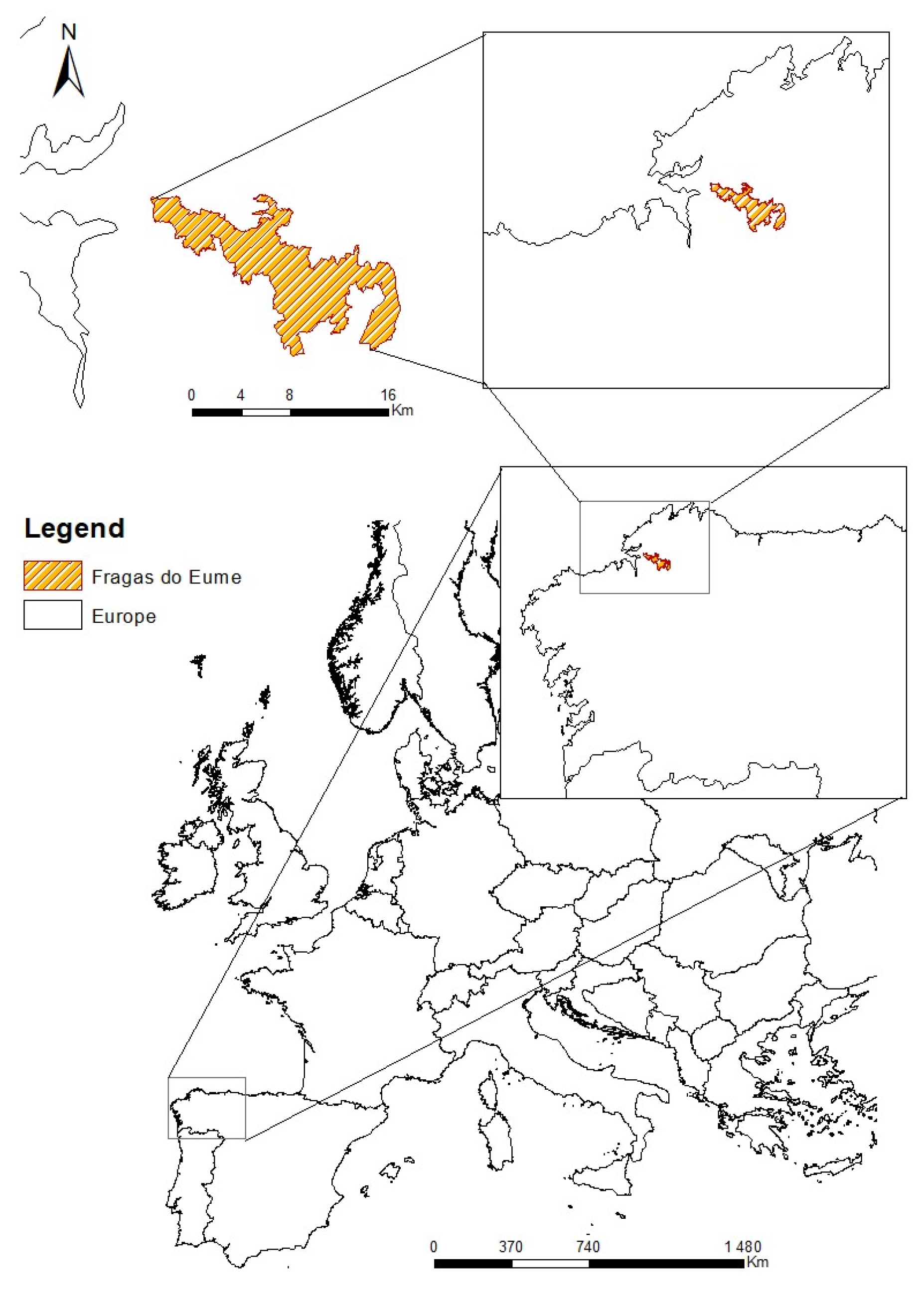
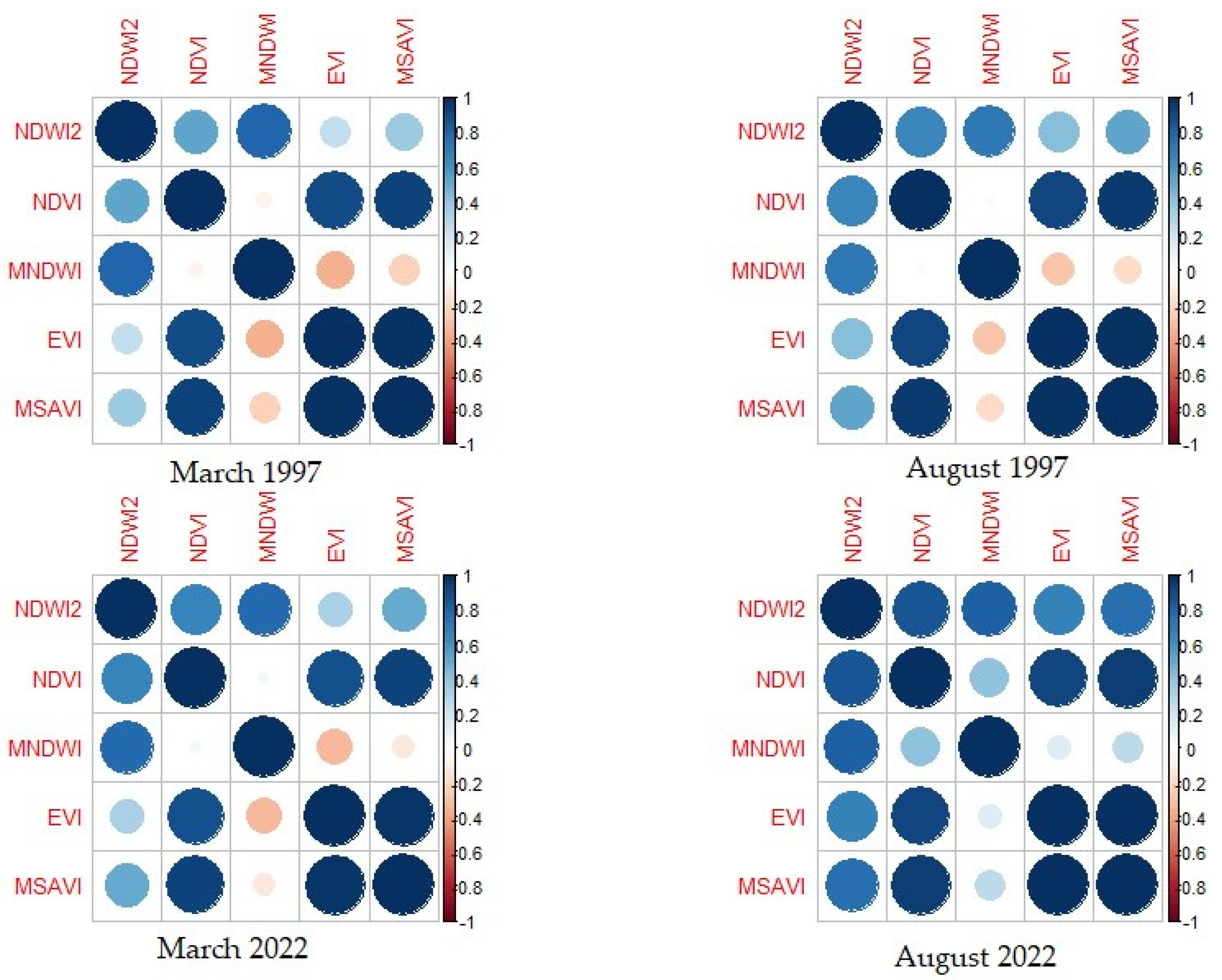
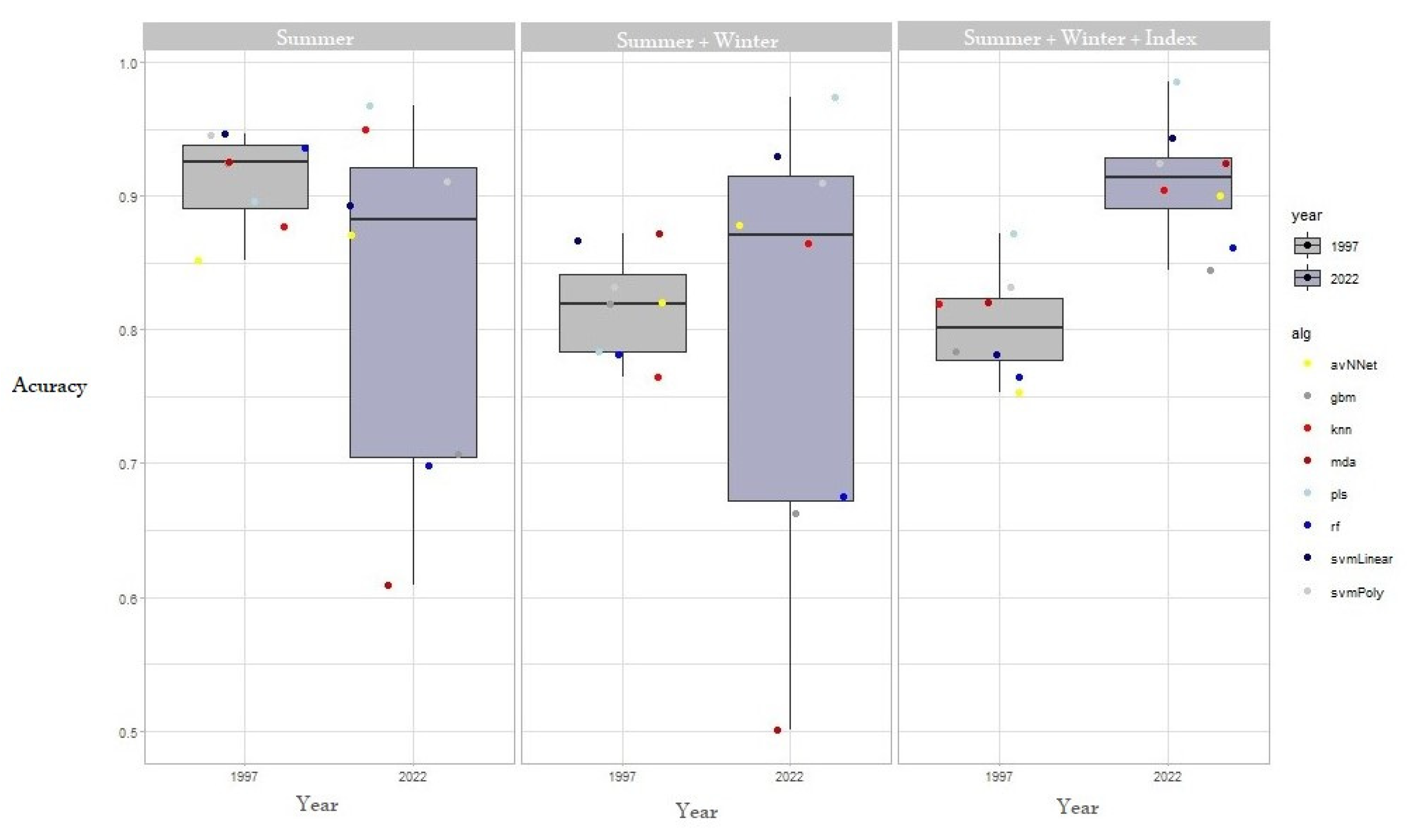
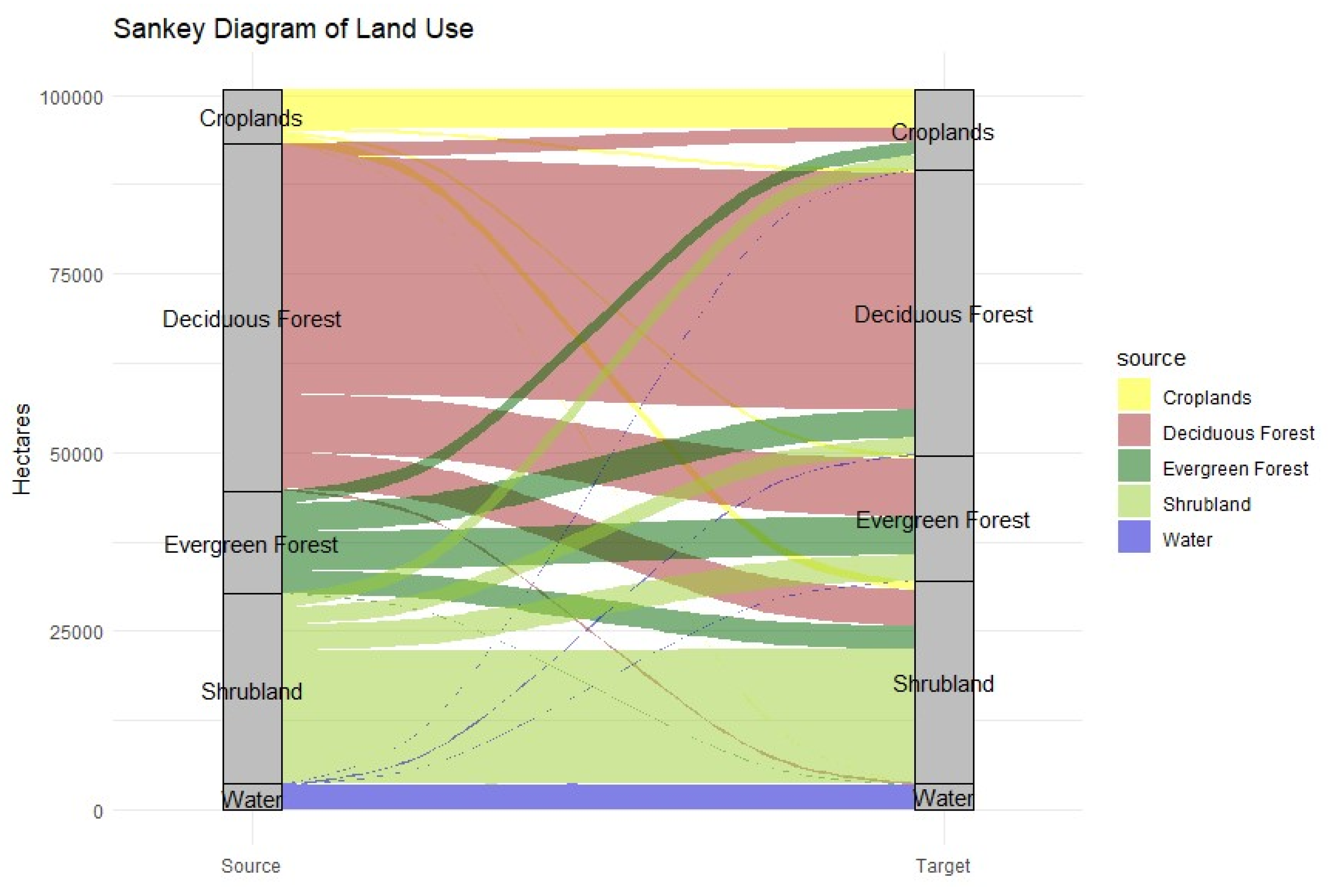
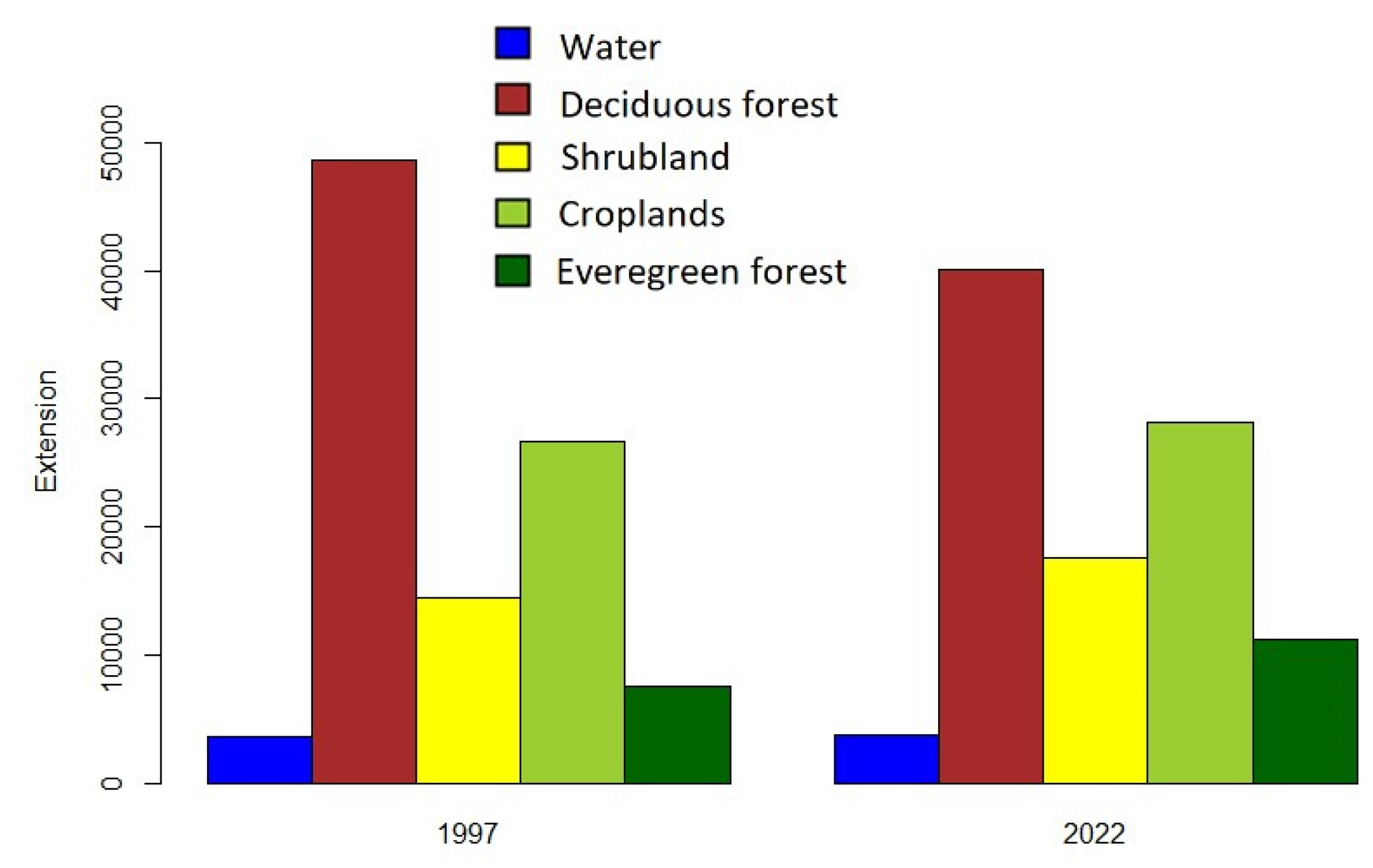
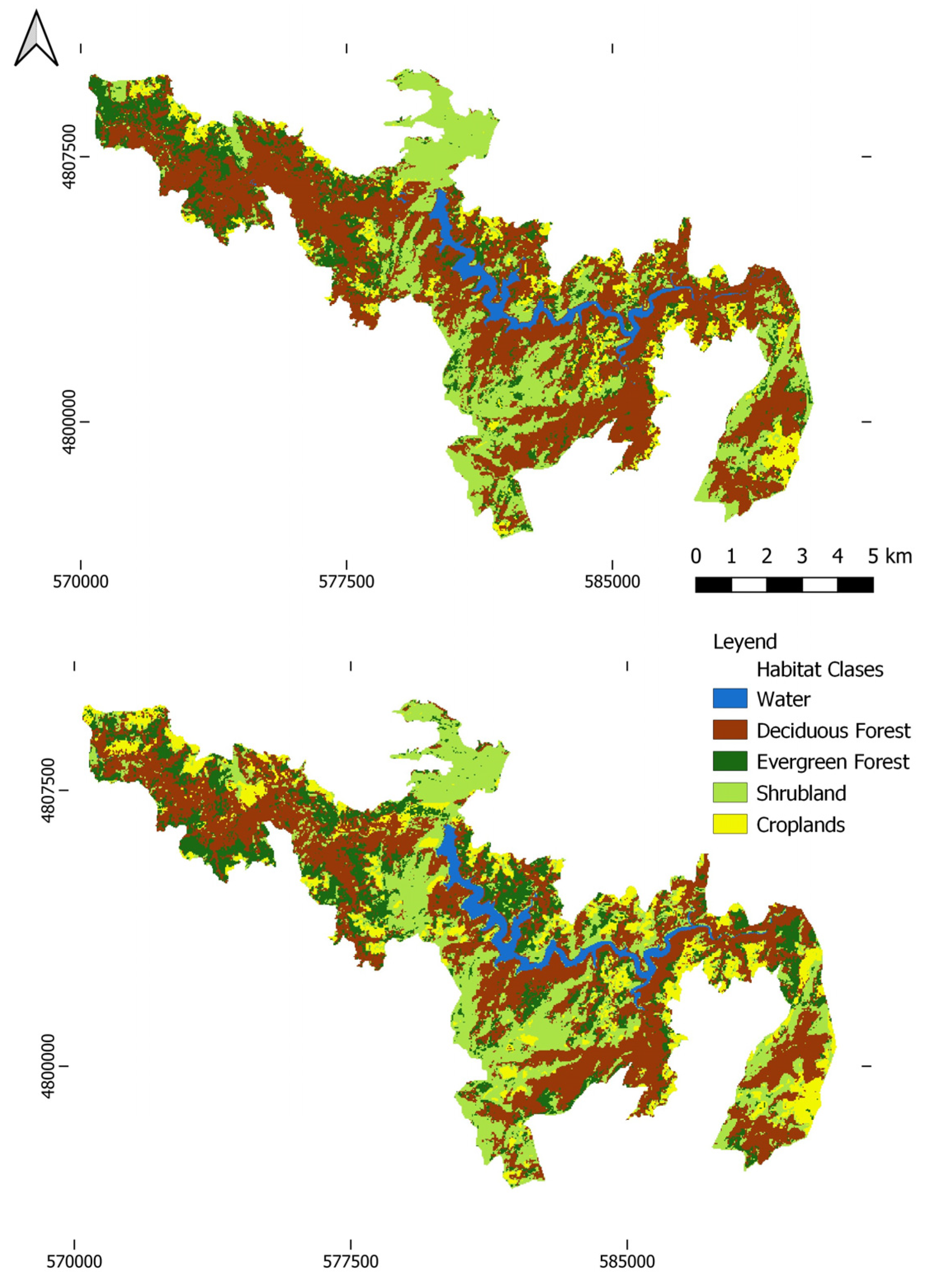
| Index | Formula | Rational |
|---|---|---|
| NDWI2 | (Green − NIR)/(Green + NIR) | NDWI2 is used to enhance the presence of water bodies by taking advantage of the strong absorption of shortwave infrared (SWIR) and high reflectance of green wavelengths by water. |
| MNDWI | (Green − SWIR)/(Green + SWIR) | MNDWI improves the delineation of water bodies in environments where NDWI might be less effective, particularly in built-up areas |
| NDVI | (NIR − Red)/(NIR + Red) | NDVI is widely used to quantify vegetation health and cover by measuring the difference between near-infrared (which vegetation strongly reflects) and red light (which vegetation absorbs). |
| EVI | G × ((NIR − Red)/((NIR) + (C1 × Red) − (C2 × Blue) + L)) | EVI is designed to optimise the vegetation signal with improved sensitivity in high biomass regions and better correction for atmospheric conditions and soil background signals. |
| SAVI | (NIR − Red) × (1 + L)/(NIR + Red + L) | MSAVI is tailored to minimise soil brightness influences, making it more effective in areas with sparse vegetation cove |
| Land Cover Classes | Habitat Code | Natural Habitats Listed in the Habitats Directive |
|---|---|---|
| Water areas | 3160 | Natural dystrophic lakes and ponds |
| 3260 | Lowland to montane rivers with vegetation of Ranunculion fluitantis y de Callitricho-Batrachion | |
| 3270 | Rivers with muddy banks with Chenopodion rubri p.p. and Bidention p.p. vegetation | |
| Shrubland | 4030 | European dry heaths |
| * 5230 | Arborescent matorral with Laurus nobilis | |
| Croplands | * 6220 | Pseudo-steppes with grasses and annuals of the Thero-Brachypodietea |
| * 6230 | Species-rich Nardus grasslands on siliceous substrates in mountain areas (and sub-mountain areas in Continental Europe) | |
| 6410 | Molinia meadows on calcareous, peaty, clay-like, or silt-laden soils (Molinion caeruleae) | |
| 6430 | Hydrophilic tall herb fringe communities of the plains and of the montane-to-alpine levels | |
| 6510 | Lowland hay meadows (Alopecurus pratensis, Sanguisorba officinalis) | |
| Deciduous forest | * 9180 | Tilio-Acerion forests of slopes, screes and ravines |
| * 91E0 | Alluvial forests with Alnus glutinosa and Fraxinus excelsior (Alno-Padion, Alnion incanae, Salicion albae) | |
| 9230 | Galicio–Portuguese oak woods with Quercus robur and Quercus pyrenaica | |
| 9260 | Castanea sativa woods | |
| Evergreen forest |
| Habitat | 1997 | 2022 | 1997 | 2022 |
|---|---|---|---|---|
| Polygons | Hectares | |||
| Water | 12 | 18 | 43 | 51 |
| Deciduous forest | 11 | 14 | 89 | 61 |
| Shrubland | 14 | 20 | 73 | 92 |
| Croplands | 16 | 21 | 7 | 19 |
| Evergreen forest | 11 | 11 | 27 | 53 |
| Habitat | 1997 | 2022 |
|---|---|---|
| Hectares | ||
| Water | 323 | 337 |
| Deciduous forest | 4379 | 3607 |
| Shrubland | 1295 | 1584 |
| Croplands | 2399 | 2540 |
| Evergreen forest | 682 | 1011 |
Disclaimer/Publisher’s Note: The statements, opinions and data contained in all publications are solely those of the individual author(s) and contributor(s) and not of MDPI and/or the editor(s). MDPI and/or the editor(s) disclaim responsibility for any injury to people or property resulting from any ideas, methods, instructions or products referred to in the content. |
© 2024 by the authors. Licensee MDPI, Basel, Switzerland. This article is an open access article distributed under the terms and conditions of the Creative Commons Attribution (CC BY) license (https://creativecommons.org/licenses/by/4.0/).
Share and Cite
Díaz-García, P.; Regos, A. Assessing Land-Cover Changes in the Natural Park ‘Fragas do Eume’ over the Last 25 Years: Insights from Remote Sensing and Machine Learning. Land 2024, 13, 1601. https://doi.org/10.3390/land13101601
Díaz-García P, Regos A. Assessing Land-Cover Changes in the Natural Park ‘Fragas do Eume’ over the Last 25 Years: Insights from Remote Sensing and Machine Learning. Land. 2024; 13(10):1601. https://doi.org/10.3390/land13101601
Chicago/Turabian StyleDíaz-García, Paula, and Adrián Regos. 2024. "Assessing Land-Cover Changes in the Natural Park ‘Fragas do Eume’ over the Last 25 Years: Insights from Remote Sensing and Machine Learning" Land 13, no. 10: 1601. https://doi.org/10.3390/land13101601






